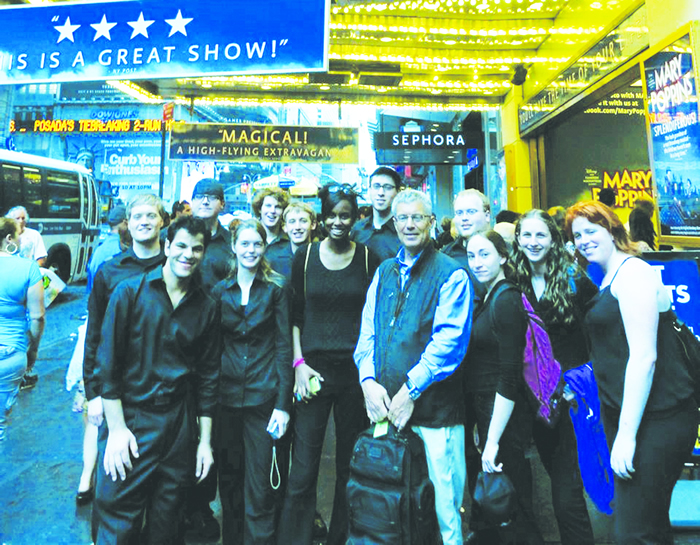Allegro
You want to play percussion on Broadway?
Volume 111, No. 10October, 2011
 Participants in this year’s Broadway Percussion Seminar/Summit learned what it takes to make it in the field. |
Want to know what it takes to be a percussionist on Broadway? The New York University Percussion Studies Program, under the direction of Jonathan Haas, recently hosted the fifth annual Broadway Percussion Seminar/Summit. The event brings together an array of renowned Broadway percussionists and participants from around the world, for a five-day intensive study of the skills, experience, and know-how necessary to succeed in the world of Broadway percussion.
“This was definitely one of the most amazing experiences I have been fortunate enough to participate in,” said Erin Shupe, who traveled from Maryland to attend the program. “As someone who aspires to someday work on Broadway musicals myself, it was absolutely incredible to attend lectures and workshops led by the actual percussionists on Broadway.”
Percussionists Dave Ratajczak and Dan Haskins from “Mary Poppins” wasted no time in showing students that having a successful career on Broadway requires more than the ability to have a good time playing the same music every night. The choreography of switching among many instruments while still watching the conductor was a big point of discussion throughout.
Another session featured percussionists from the show “How to Succeed in Business Without Really Trying.” Paul Pizzuti and Erik Charlston discussed in great detail the importance of having a heightened musical sensibility and how your part fits in with the orchestra.
Later, Ben Herman spoke about the fast-paced environment of studio recording, including how to prepare for sight-reading sessions and how to discern the best setup for the situation.
Monte Hatch offered his clinic on Leonard Bernstein’s opera “A Quiet Place.” Aside from the music, Mr. Hatch spoke extensively on what it’s like playing for the NYC Opera and how it differs from playing in a Broadway pit.
Bill Hayes and John Meyers, percussionists for “Anything Goes,” discussed the critical skill sets a percussionist must have to take advantage of the many opportunities Participants in this year’s Broadway Percussion Seminar/Summit learned what it takes to make it in the field. available in musical theatre.
In a slight departure from the other sessions, Javier Diaz presented a hands-on clinic. With a background in both Latin and Western classical music, he discussed the different perceptions of rhythm that each tradition emphasizes. Following a brief history of Afro-Cuban percussion, students participated in a big jam session with singing, improvisation and a lot of drumming.
Another session was led by Kory Grossman, “Broadway’s super sub.” Mr. Grossman explained how much goes into preparing a book for performance, some of the techniques he uses, and frequently stressed that there is more to music than the notes alone.
At one point, the entire group took the subway up to the theater district to visit Broadway. Everyone had the opportunity to view one show from the pit and one from the audience. The chance to see how the players and conductors interact in the pit, with the background knowledge of having learned the books in preparation, was a fantastic experience from which the students gleaned much knowledge.
Following the show, everyone met at Local 802 for dinner and a discussion led by Ray Marchica and David Nyberg from “Mamma Mia.” They talked about the purpose of Local 802 and what services the union provides to protect musicians.
The final event of the seminar was a roundtable discussion, which brought together all of the percussionists who had presented throughout the week, in addition to contractors John Miller and Mike Keller.
“On that last day when I looked around the room and saw all the heavy cats who have been in the biz forever, and all of us trying to make it, I knew what the seminar meant to me,” said Tony Hofmeir, who came from Colorado. “I went to New York not knowing what to expect and I left with a profound understanding of musical theatre and a notebook full of contact info for all those guys in the room who had made it big! I had a great experience and met a ton of great players, both older and younger.”
This story originally appeared in the October 2011 issue of Allegro, the magazine of the New York City musicians’ union (AFM Local 802). For reprint requests, send an e-mail to editor Mikael Elsila at Allegro@Local802afm.org.
